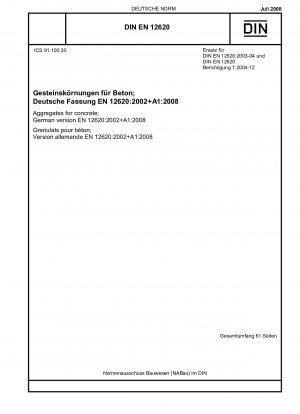DIN EN 12620:2008
Aggregates for concrete; German version EN 12620:2002+A1:2008
- Standard No.
- DIN EN 12620:2008
- Release Date
- 2008
- Published By
- German Institute for Standardization
- Status
- Replace By
- DIN EN 12620:2013
- DIN EN 12620:2008-07
- Latest
- DIN EN 12620 E:2015-07
- Replace
- DIN EN 12620:2003 DIN EN 12620 Berichtigung 1:2004 DIN EN 12620/A1:2006
- Scope
- This European Standard specifies the properties of aggregates and filler aggregates obtained by processing natural, manufactured or recycled materials and mixtures of these aggregates for use in concrete. It covers aggregates having an oven dried particle density greater than 2,00 Mg/m3 (2 000 kg/ms) for all concrete, including concrete in conformity with EN 206-1 and concrete used in roads and other pavements and for use in precast concrete products. ID It also covers recycled aggregate with densities between 1,50 Mg/m3 (1 500 kg/m3) and 2,00 Mg/m3 (2 000 kg/m3) with appropriate caveats and recycled fine aggregate (4 mm) with appropriate caveats. It also specifies that a quality control system is in place for use in factory production control and it provides for the evaluation of conformity of the products to this European Standard. This standard does not cover filler aggregates to be used as a constituent in cement or as other than inert filler aggregates for concrete. NOTE 1 Aggregates used in construction should comply with all the requirements of this European Standard. As well as familiar and traditional natural and manufactured aggregates Mandate M/125 "Aggregates" included recycled aggregates and some materials from new or unfamiliar sources. Recycled aggregates are included in the standards and new test methods for them are at an advanced stage of preparation. For unfamiliar materials from secondary sources, however, the work on standardisation has only started recently and more time is needed to define clearly the origins and characteristics of these materials. In the meantime such unfamiliar materials when placed on the market as aggregates must comply fully with this standard and national regulations for dangerous substances (see Annex ZA of the standard) depending upon their intended use. Additional characteristics and requirements may be specified on a case by case basis depending upon experience of use of the product, and defined in specific contractual documents. NOTE 2 Properties for lightweight aggregates are specified in EN 13055-1:2002.
DIN EN 12620:2008 Referenced Document
- EN 1097-1 Tests for mechanical and physical properties of aggregates - Part 1: Determination of the resistance to wear (micro-Deval)*, 2023-12-20 Update
- EN 1097-2:1998 Tests for Mechanical and Physical Properties of Aggregates - Part 2: Methods for the Determination of Resistance to Fragmentation Includes amendment A1:July 2006
- EN 1097-3 Tests for mechanical and physical properties of aggregates - Part 3: Determination of loose bulk density and voids
- EN 1097-6 Tests for mechanical and physical properties of aggregates - Part 6: Determination of particle density and water absorption*, 2022-02-23 Update
- EN 1097-8:1999 Tests for Mechanical and Physical Properties of Aggregates - Part 8: Determination of the Polished Stone Value
- EN 1097-9 Tests for mechanical and physical properties of aggregates - Part 9: Determination of the resistance to wear by abrasion from studded tyres - Nordic test*, 2014-01-01 Update
- EN 1367-1:2007 Tests for thermal and weathering properties of aggregates - Part 1: Determination of resistance to freezing and thawing
- EN 1367-2 Tests for thermal and weathering properties of aggregates - Part 2: Magnesium sulfate test*, 2024-04-19 Update
- EN 1367-4 Tests for thermal and weathering properties of aggregates - Part 4: Determination of drying shrinkage
- EN 1744-1:1998 Tests for Chemical Properties of Aggregates - Part 1: Chemical Analysis
- EN 1744-5 Tests for chemical properties of aggregates - Part 5: Determination of acid soluble chloride salts*, 2024-04-19 Update
- EN 1744-6 Tests for chemical properties of aggregates - Part 6: Determination of the influence of recycled aggregate extract on the initial setting time of cement*, 2024-04-19 Update
- EN 196-2:2005 Methods of testing cement Part 2: Chemical analysis of cement Supersedes EN 196-21:1989
- EN 932-3 Tests for general properties of aggregates - Part 3: Procedure and terminology for simplified petrographic description*, 2022-06-22 Update
- EN 932-5 Tests for general properties of aggregates - Part 5: Common equipment and calibration*, 2014-05-01 Update
- EN 933-1 Tests for geometrical properties of aggregates - Part 1: Determination of particle size distribution - Sieving method*, 2012-01-01 Update
- EN 933-3 Tests for geometrical properties of aggregates - Part 3: Determination of particle shape - Flakiness index*, 2012-01-01 Update
- EN 933-4 Tests for geometrical properties of aggregates - Part 4: Determination of particle shape - Shape index
- EN 933-7 Tests for geometrical properties of aggregates - Part 7: Determination of shell content - Percentage of shells in coarse aggregates
- EN 933-8 Tests for geometrical properties of aggregates - Part 8: Assessment of fines - Sand equivalent test*, 2015-05-01 Update
- EN 933-9 Tests for geometrical properties of aggregates - Part 9: Assessment of fines - Methylene blue test*, 2022-02-23 Update
DIN EN 12620:2008 history
- 1970 DIN EN 12620 E:2015-07 Aggregates for concrete
- 2013 DIN EN 12620:2013 Aggregates for concrete; German version EN 12620:2013
- 2008 DIN EN 12620:2008 Aggregates for concrete; German version EN 12620:2002+A1:2008
- 1970 DIN EN 12620:2003 Aggregates for concrete
- 1970 DIN EN 12620 E:1997-02 Aggregates for concrete
